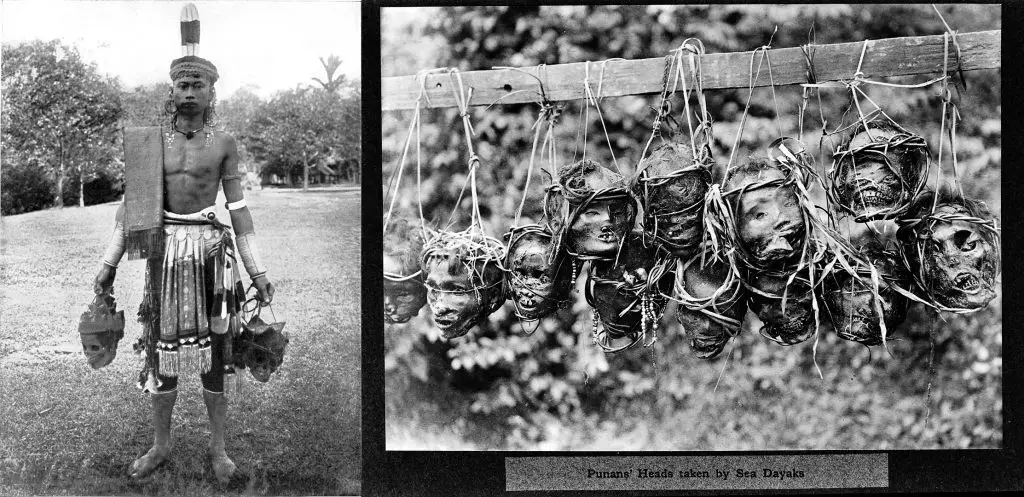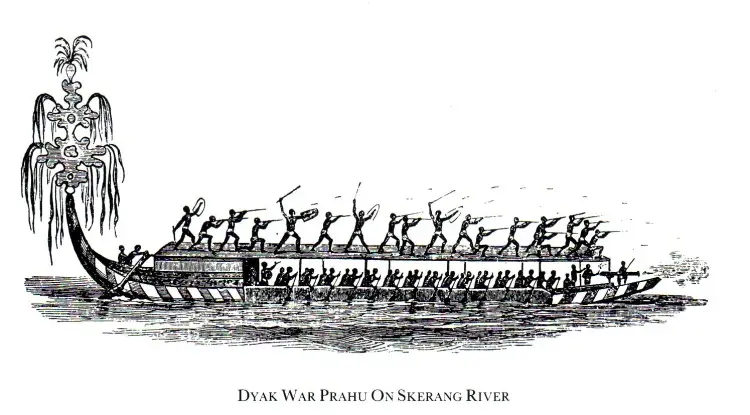Just like any other cultures in the world, Sarawak has its own sets of funeral customs varying with the different races found here.
While some funeral customs are still being practiced to this day, others are completely forgotten.
So here are 10 Sarawak funeral customs of the 19th century you probably never heard:
1.If more than two or three people die in the same house, they will most likely abandon it and move to another area.
Charles Grant in his book A Tour Amongst the Dyaks of Sarawak, Borneo in 1858 shared that it was a taboo to continue to stay in the same area if there were too many people in their village.
He wrote, “It appeared that many of the people of their village of Kuap had died, and Dyaks do not much like to live on at a place where they think themselves likely to be haunted by the ghosts of the dead.”
Similarly, Reverend William Crossland also wrote in his diary in 1867, “The Land Dyaks are spoken of as being very fickle as to their abode, one year here, another there, for if two or three die the house is forsaken and another built.”
2.The house in which a death occurred must be closed for certain amount of times.
If someone died back in those days, the house must be closed to strangers and in some communities even to its own occupants.
Bishop William Chalmers wrote in Some Account of the Land Dyaks of Upper Sarawak that this taboo must be practiced or else ghost of deceased will haunt it.
Meanwhile, another bishop Francis McDougall recorded almost the same thing.
In a paper entitled On the Wild Tribes of the N.W. Coast of Borneo, he stated, “The hill tribes have the custom of pamoli, or taboo, which on certain occasions they enforce with great strictness; they close their houses to all strangers, and no one can go inside under the penalty of death.”
3.When a Land Dayak died, his/her family must give a feast on that exact same day.
This funeral taboo was recorded by Spenser St. John. “On the day of a Land Dyak’s death, a feast is given by the family to their relations; if the deceased be rich, a pig and a fowl are killed, but if poor, a fowl is considered sufficient,” he wrote.
Another example St. John gave was of the Sea Dayak in which he stated, “If a Dayak lose his wife, he gives a feast, which is really an offering to the departed spirit.”
4.The family and those who carried the dead must trace back their steps when returning from the funeral.
Speaking of the Sea Dayak, here is another funeral tradition that is no longer practiced after returning from burying the dead.
St. John stated, “Amongst the Sea Dyaks, the relatives and bearers of the corpse must return direct to the house from which they started before entering another, as it is unlawful or unlucky to stop, whatever may be the distance to be traversed.”
5.Some communities would go for a headhunting trip as a sign of mourning.
This is one of those funeral customs that is definitely never practiced now. According to St John, the Sea Dayaks sometimes would go for headhunting trip after the death of their loved ones.
“After the death of relatives, they seek for the heads of enemies, and until one is brought in they consider themselves to be in mourning, wearing no fine clothes, striking no gongs, nor is laughing or merry-making in the house allowed; but they have a steady desire to grieve for the one lost to them, and to seek a head of an enemy, as a means of consoling themselves for the death of the departed. At the launching of a new boat, preparatory to the headhunting, the spirits presiding over it are appeased and fed, and the women collect in and about it, and chant monotonous tunes; invoking the heavenly spirits to grant their lovers and husbands success in finding heads, by which they may remove their mourning and obtain a plentiful supply of the luxuries and necessaries of life.”

6.As for the olden Melanau communities, the friends of the dead would gather for a cock-fighting session.
Meanwhile, chief resident of Sarawak William Crocker shared an interesting funeral custom practiced among the Melanaus.
“A few months after the death of a Milanow the friends assemble for a monster cock-fighting and feasting which lasts three or four days; sometimes as many as three or four hundred cocks are killed, the sacrifice being for the benefit of the departed spirit.”
7.If someone died in a room, the whole flooring is changed.
Will you renovate your house after your loved ones die in your home?
This is one of funeral customs that most probably too expensive to practise in this modern time.
According to Brooke Low, when a Sea Dayak dies back in those days, the floor of the room in which he died is changed.
8.Some objects or names which related to a dead person are taboo to touch or say.
Low also recorded another funeral custom which was practiced by the Kenyah communities in Lepo Anan and Long Sebatu.
“The camphor tree abounds in the forests of Balui Pe, but the Lepu Anans (Lepo Anan) and other may not touch it for a couple of years, out of reverence for the memory of Ana Lian Avit, the powerful Kinah (Kenyah) chief, who died a few months ago. Similarly Dian’s name may not be uttered in Long Sbatu (Long Sebatu), a Kinah village, it having been the name borne by a former chief here.”
9.A river can be taboo to fish or enter into during the mourning period.
During a journey to Lingga, the second White Rajah of Sarawak Charles Brooke witnessed another funeral custom.
He wrote in Ten Years in Sarawak (1882), “On the Lingga we passed one small rivulet tabooed in consequence of a rich chief having lately died, there were some spears stuck into the bank, and poles fixed across. No one could break through these impediments without incurring a severe fine; but when the time of mourning (ulit) is expired, the relatives of the deceased poison the fish in the stream, and of the population can be present to spear them after which the taboo is opened.”
10.A widow must not leave her room for seven days and she cannot marry again until Gawai Antu.
This funeral custom was practiced by those who lived in Undup back in those days. Crossland recorded, “If the deceased be a married man the widow many not leave her room for seven days; so everything here requires is brought to her; she wails for her dead husband mourning and evening; she may not marry again until after the Gawai Antu.”
If she did get married, she is fined for adultery as if her husband were alive. According to custom, she still belongs to the husband until the performance of the last rites of the Gawai Antu.



































